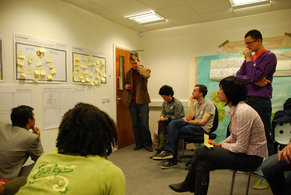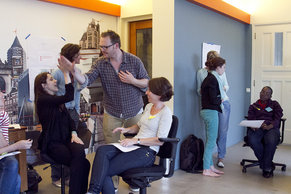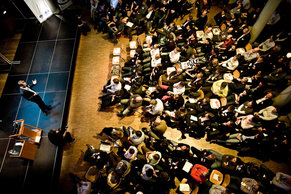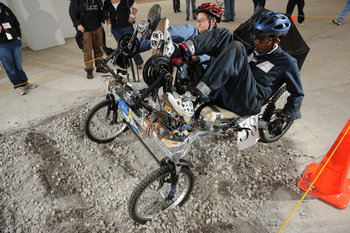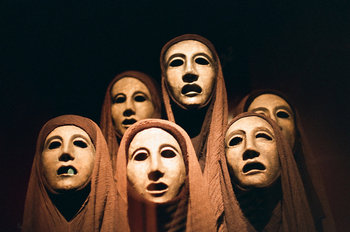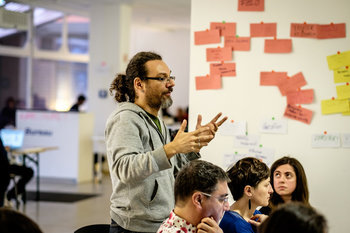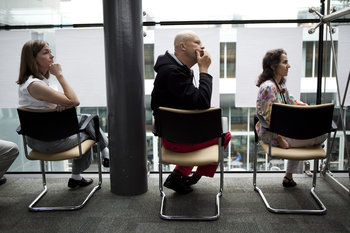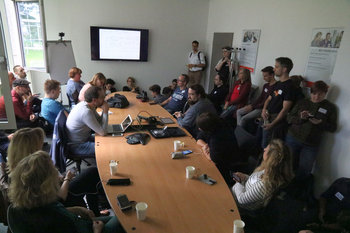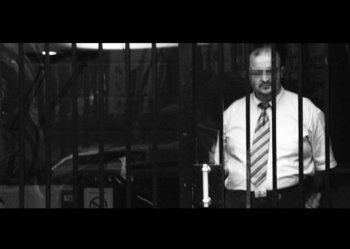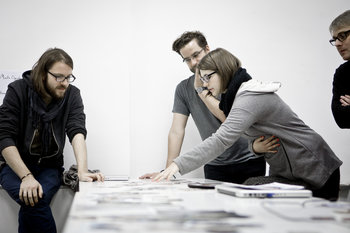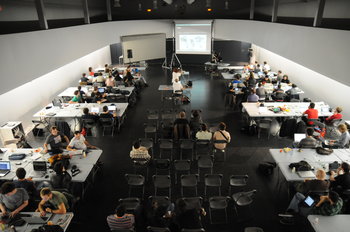
Leadership
A mid-sized digital advertising firm brings in a new chief executive officer who was previously a technology executive at a large bank. The new CEO hires a dozen people from his previous company and gives them key executive positions. This results in the culture of the large bank being transplanted to the smaller firm with a more conservative and risk managed culture emerging.Tone At The Top
A technology startup has a culture of spending lavishly as growth is going well and profitability seems like a remote future problem. Investors concerned with the cash burn rate of the firm bring in a CEO from the travel industry who is known for her cost cutting prowess. The CEO immediately sets an example for all with stories of how she always travels by economy and stays in three star hotels to improve the bottom line. Suddenly managers are called to account for their spending and a culture of conserving resources begins to take hold.Job Security
A governmental organization has a culture of guaranteed job security whereby senior staff are comfortable with a slow rate of change and are focused on 5 year plans that are often shifted out without anyone noticing. A political and economic change results in rumors of large job cuts. This has a dramatic impact on the culture of the firm. The pace of change, activity and internal competition picks up.Storytelling
A firm that was once amongst the largest global firms in terms of revenue almost failed in the 1980s due to corporate narcissism whereby there was a culture of underestimating the competition and disrespecting the customer. The firm survives and learns from the experience. For example, executives often repeat the story of how the firm was almost destroyed and warns employees of the dangers of overconfidence and arrogance. With decades of perseverance, corporate narcissism is replaced by a culture with a healthy fear of the competition and respect for customers.Epic Meaning
A bicycle helmet company is popular with customers but is known to safety regulators as having a poor quality product. A high profile incident causes safety lapses to be widely recognized resulting in a declining brand image amongst customers and employees alike. The CEO is fired and a new CEO is brought in who has a stellar reputation in areas such as quality, safety and sustainability. The CEO gives the company a new mission to be the safest, highest quality, most sustainable and fun product on the market. This is followed by extensive product redesigns that are consistent with this mission. The culture shifts from being unaware of safety and mostly focused on look and feel to a culture of safety first. This improves employee morale and allows engineers who understand product safety to gain more influence and authority within the company.Management by Walking Around
An executive management team at a large telecom company has an isolated culture whereby decisions are made in a small group without consultation with employees. The executive team hands down its strategy to the firm but often finds this doesn't get implemented as expected. The CEO begins to have skip level lunch meetings with people at every level of the firm and finds that people view strategy as disconnected from reality. Based on this the CEO requires all executives to hold regular skip level meetings and to have an open door policy. The firm slowly shifts to a culture of management by walking around whereby leadership are aware of operational realities and employees are aware of the competitive pressures facing the firm.Change Management
An insurance company suffers from a culture of resistance to change whereby IT projects commonly fail due to a lack of support and enthusiasm from employees. After a series of expensive failed IT projects the executive team begins an aggressive program of change management with intensive communication and handling of issues. Managers sideline anyone who appears to stand in the way of projects and empowers agents of change. With time, the culture shifts with the clear expectation that making things happen is good for your career and throwing up roadblocks to strategy is unacceptable.Process
Business units at an airline are dissatisfied with the performance of the IT department. IT teams have a cowboy atmosphere with impromptu processes and prioritization of work. For example, business units feel that requests are serviced faster if you are extremely friendly to IT team members. In order to address this culture, the airline implements a complete service management process whereby all requests are systematically tracked and consistently managed. This process calls for business units to be treated as an internal customer with a service desk and the opportunity to rate their satisfaction with all submitted requests. As the process takes hold and IT staff are evaluated on measurable performance and client satisfaction metrics, the cowboy culture is defeated and IT staff become more diligent, consistent and customer-focused in their work.Structure
A manufacturing firm places responsibility for production targets and quality control under the same managers. This leads to managers meeting production targets by loosening quality control. Employees become accustomed to this and a culture of poor quality takes hold whereby employees lack diligence to address quality issues. The firm restructures quality control as a new executive role with the same level of authority as production managers. This role isn't measured based on production targets and is only concerned with assuring quality. This results in a healthy contentious relationship between quality control and production teams. The culture shifts and diligence around quality issues improves.Measurement
A telecom company has a low customer satisfaction rate of 36% with a poor service culture characterized by an antagonistic approach to customer service. In order to address this, the firm begins to measure customer satisfaction for every interaction and use this data to give regular performance feedback to staff. This results in friendly and helpful staff being rewarded and unhelpful and confrontational staff being displined. With time, the service culture begins to improve.Policy
A luxury hotel has a relatively poor service culture for its industry with customers often ranking service as unfriendly or unprofessional. The hotel begins to shape its service culture with policies such as respecting the customer at all times, even behind their backs. This means that employees would be disciplined for talking about customers in a derogatory fashion in the break room. Policies like this begin to improve the hotel's service culture with it becoming a norm to view customers positively and afford them generous respect.Controls
A pharmaceutical company has a bureaucratic culture whereby processes, procedure and policy have become inefficient. The firm begins to reshape controls with self-organizing cross-functional teams that do things as they like without cross-departmental policies, procedures and politics getting in the way. This results is a more creative culture with work products that are faster, higher quality and more innovative.Communication
A firm has a highly political and negative culture whereby negative tactics are common. The HR department embarks on a program of intensive communication whereby real complaints are anonymized and communicated to all employees as examples of unacceptable behavior. For example, the HR team receives complaints from an older worker about ageist comments they have faced in meetings. They anonymize these incidents by changing details and give it as an example at a monthly all-hands meeting of inappropriate behavior. This slowly builds a more positive working culture as employees begin to recognize patterns of unacceptable behavior.Summary
The following are additional examples of organizational culture change: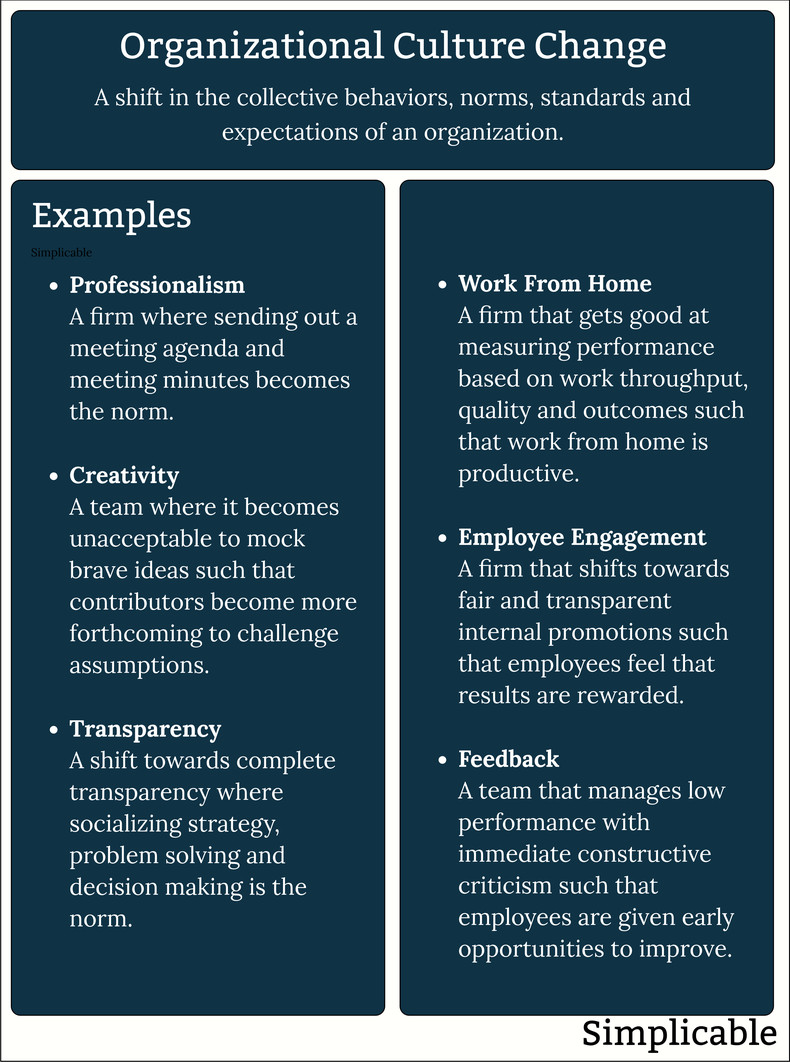
| Overview: Organizational Culture Change | ||
Type | ||
Definition | A shift in the values, norms, expectations, habits, symbols and mission of an organization. | |
Related Concepts | ||

